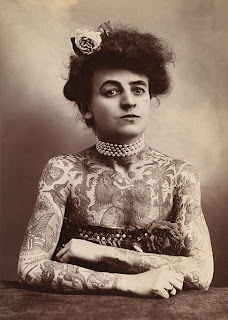Amricani Hospital then..
And now..
A fascinating visit to the Blogger's Night last night at the Amricani Cultural Centre, formerly known as Amricani Hospital or by it's proper name Mylrea Memorial Hospital; but no one calls it that. A wonderful refurbishment and tribute to the interesting history of Kuwait. A tender appreciation of those American missionary doctors, some of whom lived and served here all their lives and chose to be buried here.
Dr. Stanley Mylrea (Chief of Medicine, Amricani Hospital, Kuwait)
and his wife in Arab attire.

An insight in to Sheikh Mubarak Al-Sabah's brave foresight and understanding of the need for progress, as scary as it may have seemed (there is an old dentist's chair and tools in the exhibition and one can only imagine the sheer panic at seeing that for the first time.) But at a time when smallpox and trachoma, were widely spread, then these doctors must have seemed like answers to a pray.
Sheikh Mubarak Al-Sabah (1896-1915)
“… These men! Who are they? Are they diplomats? Are they politicians? Merchants? No! These men have come here to teach us. They will build a hospital and take care of our sick. Everybody dies today but when these men come we shall have our sick attended to.”
Going back in time at Amricani Cultural Centre exhibit, a small museum featuring some short films on the past history of Amricani, a chronological, geographical map of the development of the health care and hospitals here in Kuwait, prominent people in Kuwait's medical history, also some objects and settings of when Amricani was first being used as a hospital...
The dentist's chair
The surgeon's tools
The Amricani Cultural Center is currently the headquarters of Dar al Athar al Islamiyya. Besides holding the DAI’s offices, the completely restored American Mission Hospital also hosts events such as lectures, workshops, exhibitions and performing arts. The Amricani opened to the public after in 2011.
The American Hospital first opened in 1911 and was probably the first modern hospital in the Gulf. It closed in 1967 and was abandoned until 2000. From 2000 until 2011 the building was restored and renovated with the support of the UNESCO. It now houses the DAI’s impressive Islamic arts and culture library – including many rare manuscripts – in the former women’s wing and the cultural center in the men’s wing.
The cultural center consists of a 200-seat theatre, temporary exhibition spaces, a permanent exhibit on the history of the hospital, a conservation laboratory and a training center, where museum staff is being trained with the support of the UNDP.
We had the absolute privilege to view part of the fantastic collection of Indian Mughul jewelled art entitled, "The Treasury of the World" an incredible exhibition housed upstairs. The Mughul period was 1526-1858.
The collection has now come home again, at last, after a 10 year world tour having been showcased at The British museum and The Hermitage, to name just a few. Read one of the reviews in the New York Times of the exhibit [link].
I first learned of TOW after reading a very interesting interview given by the owner/director Sheikha Hussa Al-Sabah whilst she visited the exhibit in Malayasia [link]. The collection is owned and lovingly cared for by Sheikha Hussa and her husband, Sheikh Nasser Sabah Al-Ahmed Al-Sabah.
This will, undoubtedly, be the number one destination for residents and any visitors to Kuwait. It will be open to the public soon (perhaps as soon as January 2012).
To learn more about this incredible Al Sabah collection and Dar al-Athar al-Islamiyyah [link] . Keep updated about their DAI on Facebook [link], also if you're Twittering [link].
Al Amricani Cultural Centre and Administrative Offices
in the Historic Amricani Hospital Buildings
in the Historic Amricani Hospital Buildings
Tel: (965) 2240 0992
Fax: (965) 2246 7770
Email: info@darmuseum.org.kw
Fax: (965) 2246 7770
Email: info@darmuseum.org.kw
Map- click to enlarge
The stunning "Treasury of the World" Exhibition.
The Mughal collection comprises of many elaborate bejewelled necklaces, thick bracelets, plume-like turban ornaments, protective rings for archery, hookah mouthpieces and elongated hair ornaments, as well as jewel-encrusted boxes, fly whisks, dozens of swords and daggers and scabbards. Precious stones used in abundance include diamonds, rubies, emeralds and natural pearls.
Turban brooch

Turban brooches and rings.
The exquisite, jewelled ring on the far left above and larger pic below has a moveable head and a secret compartment for poison in case the wearer was captured and needed to commit suicide before the gruesome torture began.

Adorned cups
Diamond and pearl necklace

Dagger, scabbard and jewel encrusted hair swisher 3rd from right
Pearl and jewel necklace
Hookah water reservoirs
Emerald turban brooch
White jade
Extensive collection of daggers
This photo on display has been blown up to almost adult size to show the very intricate details of the original miniature painting.
The astounding collection is not to be missed! Will keep you posted when it opens to the public. A very proud moment for the Kuwaitis indeed.
LWDLIK- Thank you to the wonderful people at DAI and to my young photographer Ibrahim Al Athari.































